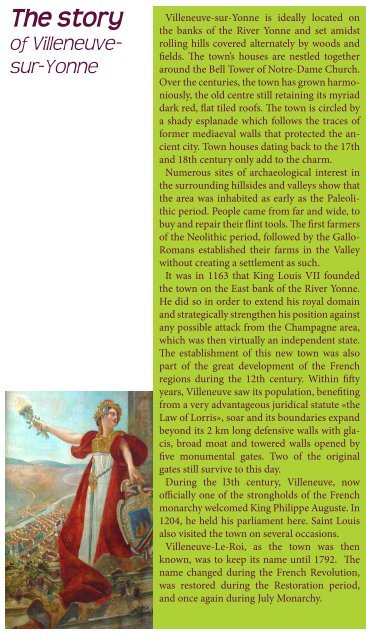Tourist guide - Office de Tourisme de Villeneuve-sur-Yonne
Tourist guide - Office de Tourisme de Villeneuve-sur-Yonne
Tourist guide - Office de Tourisme de Villeneuve-sur-Yonne
You also want an ePaper? Increase the reach of your titles
YUMPU automatically turns print PDFs into web optimized ePapers that Google loves.
The story<br />
of <strong>Villeneuve</strong><strong>sur</strong>-<strong>Yonne</strong><br />
<strong>Villeneuve</strong>-<strong>sur</strong>-<strong>Yonne</strong> is i<strong>de</strong>ally located on<br />
the banks of the River <strong>Yonne</strong> and set amidst<br />
rolling hills covered alternately by woods and<br />
fields. The town’s houses are nestled together<br />
around the Bell Tower of Notre-Dame Church.<br />
Over the centuries, the town has grown harmoniously,<br />
the old centre still retaining its myriad<br />
dark red, flat tiled roofs. The town is circled by<br />
a shady esplana<strong>de</strong> which follows the traces of<br />
former mediaeval walls that protected the ancient<br />
city. Town houses dating back to the 17th<br />
and 18th century only add to the charm.<br />
Numerous sites of archaeological interest in<br />
the <strong>sur</strong>rounding hillsi<strong>de</strong>s and valleys show that<br />
the area was inhabited as early as the Paleolithic<br />
period. People came from far and wi<strong>de</strong>, to<br />
buy and repair their flint tools. The first farmers<br />
of the Neolithic period, followed by the Gallo-<br />
Romans established their farms in the Valley<br />
without creating a settlement as such.<br />
It was in 1163 that King Louis VII foun<strong>de</strong>d<br />
the town on the East bank of the River <strong>Yonne</strong>.<br />
He did so in or<strong>de</strong>r to extend his royal domain<br />
and strategically strengthen his position against<br />
any possible attack from the Champagne area,<br />
which was then virtually an in<strong>de</strong>pen<strong>de</strong>nt state.<br />
The establishment of this new town was also<br />
part of the great <strong>de</strong>velopment of the French<br />
regions during the 12th century. Within fifty<br />
years, <strong>Villeneuve</strong> saw its population, benefiting<br />
from a very advantageous juridical statute «the<br />
Law of Lorris», soar and its boundaries expand<br />
beyond its 2 km long <strong>de</strong>fensive walls with glacis,<br />
broad moat and towered walls opened by<br />
five monumental gates. Two of the original<br />
gates still <strong>sur</strong>vive to this day.<br />
During the l3th century, <strong>Villeneuve</strong>, now<br />
officially one of the strongholds of the French<br />
monarchy welcomed King Philippe Auguste. In<br />
1204, he held his parliament here. Saint Louis<br />
also visited the town on several occasions.<br />
<strong>Villeneuve</strong>-Le-Roi, as the town was then<br />
known, was to keep its name until 1792. The<br />
name changed during the French Revolution,<br />
was restored during the Restoration period,<br />
and once again during July Monarchy.


